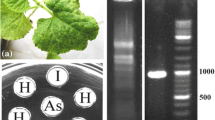Abstract
Celery latent virus has been isolated from plants of celeriac (Apium graveolens var.rapaceum).Chenopodium amaranticolor andC. quinoa are good assay plants. Celery (A. graveolens var.dulce) and celeriac (13 cultivars tested) did not react with visible symptoms.
Fourteen new artificial hosts were found. New systemic symptomless hosts areAnthriscus cerefolium, Nicotiana megalosiphon, Pisum sativum, Spinacia oleracea andTrifolium incarnatum. Systemic symptoms were caused in the pea cultivars Cicero and Dark Skin Perfection.
Five aphid species, includingCavariella aegopodii, four of which not tested with the virus before, were unable to transmit the virus.
Seed transmission was confirmed in celeriac (up to 34%) and inC. quinoa (up to 67%) and detected for the first time inAmaranthus caudatus. Detection is easier in seedlings and germinated seeds than in dry seeds.
Results of purification were erratic but best at high pH (8 or 9). Sedimentation coefficient was 161 S.
An antiserum reacted with purified virus in micro-precipitin tests (titer 256) but, especially at high salt concentrations also in agar gel (titer 64), presumably because of easy degradation of virus protein. Reactions in agar gel also occurred with crude extracts from virus-infectedC. quinoa and celeriac.
With the electron microscope flexuous virus particles were found in low concentration in crude sap and in high concentration in purified preparations. Particle measurements revealed an average length of 885 nm (in one preparation 940 nm).
Light microscopy did not show inclusion bodies in epidermal strips nor did electron microscopy of ultrathin sections reveal pinwheels and other structures typical of the potyvirus group. The virus evidently belongs to a new morphological group, possibly together with some other viruses hitherto insufficiently studied.
The virus seems of potential economic importance only, but it is advised to use virus-free mother plants of celery for seed production.
Similar content being viewed by others
References
Bos, L., 1973. Identificatie van enkele virussen in knolselderij. Gewasbescherming 4: 15.
Bos, L., 1975. The application of TMV particles as an internal magnification standard for determining virus particle sizes with the electron microscope. Neth. J. Pl. Path. 81: 168–175.
Brandes, J. & Luisoni, E., 1966. Untersuchungen über einige Eigenschaften von zwei gestreckten Sellerieviren. Phytopath. Z. 57: 277–288.
Chairez, R. & Lister, R. M., 1973. Soluble antigens associated with infection with apple chlorotic leaf spot virus. Virology 54: 506–514.
Dunez, J., Marenaud, C. & Delbos, R., 1975. Bark split disease of prune trees and its association with strains of apple chlorotic leaf spot. Acta Hortic. 44: 81–91.
Hollings, M., Stone, O. M. & Bock, K. R., 1976. Purification and properties of sweet potato mild mottle, a white-fly borne virus from sweetpotato (Ipomoea batatas) in East Africa. Ann. appl. Biol. 82: 511–528.
Lister, R. M., 1970. Apple chlorotic leaf spot virus. C.M.I./A.A.B., Descr. Pl. Viruses No. 30, 4 pp.
Luisoni, E., 1966. Un nuovo virus del sedano (Apium graveolens L.) (With summary: A new virus of celery,Apium graveolens L.) Atti Accad. Sci. Torino 100, 1965–66: 541–544.
Luisoni, E. & Lisa, V., 1969. Investigations on some virus diseases of celery. Annls. Phytopath. 1: 375–381.
Markham, R., 1960. A graphical method for the rapid determination of sedimentation coefficients. Biochem. J. 77: 516–519.
Verhoyen, M., Esparza-Duque, J., Matthieu, J. L. & Horvat, F., 1976. Identification du virus latent du céléri en Belgique. Parasitica 32: 158–166.
Walkey, D. G. A. & Mitchell, J., 1969. Studies on a ‘strap-leaf’ disease of celery caused by strawberry latent ringspot virus. Plant Path. 18: 167–172.
Walkey, D. G. A. & Whittingham-Jones, S. G., 1970. Seed-transmission of strawberry latent ringspot virus in celery (Apium graveolens var.dulce), Plant Dis. Reptr 54: 802–803.
Author information
Authors and Affiliations
Additional information
participating in the investigations from August 20th to December 19th 1972, supported by a fellowship of the Fundacion ‘Juan March’, Madrid, Spain.
Rights and permissions
About this article
Cite this article
Bos, L., Diaz-Ruiz, J.R. & Maat, D.Z. Further characterization of celery latent virus. Netherlands Journal of Plant Pathology 84, 61–79 (1978). https://doi.org/10.1007/BF01976409
Accepted:
Issue Date:
DOI: https://doi.org/10.1007/BF01976409




